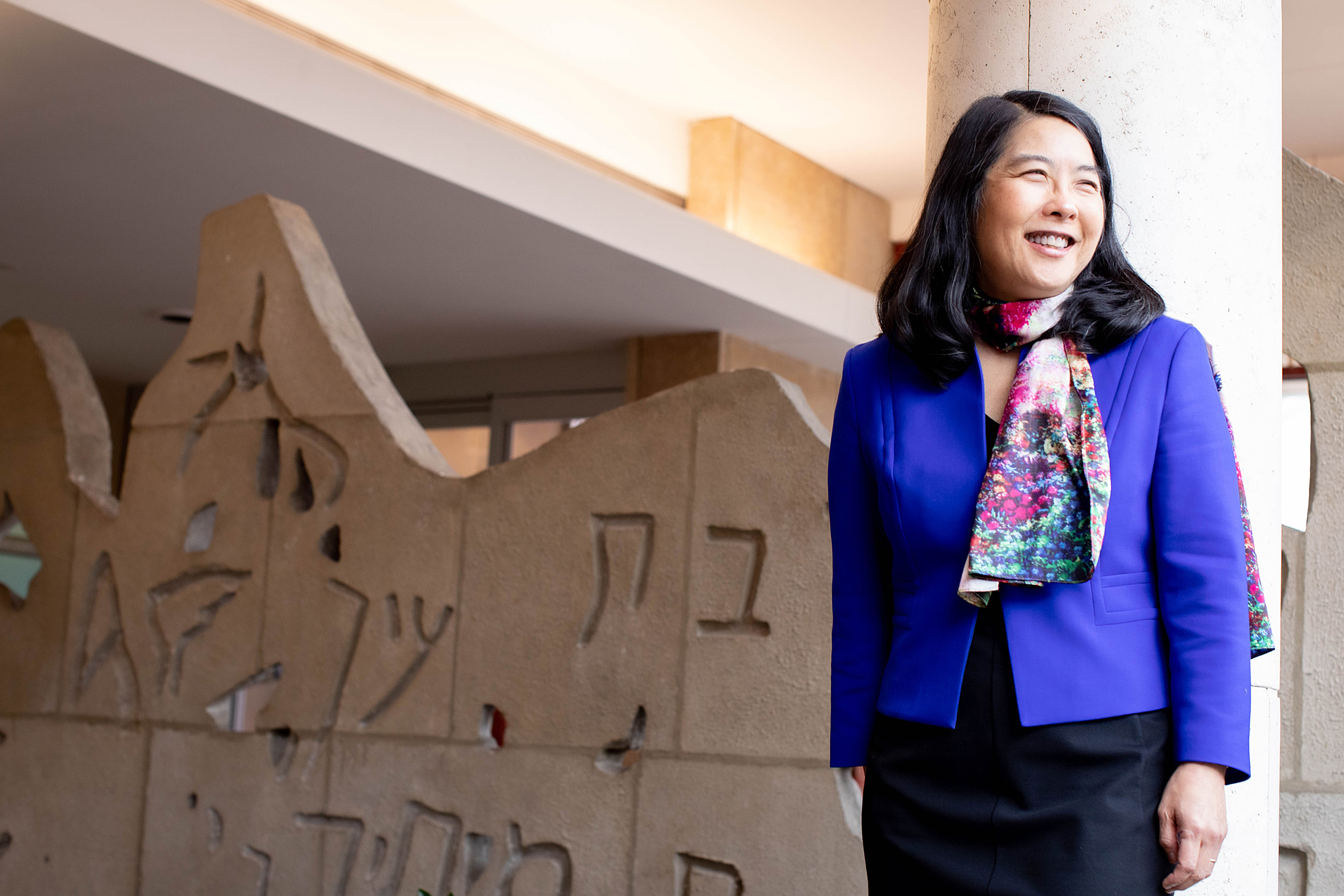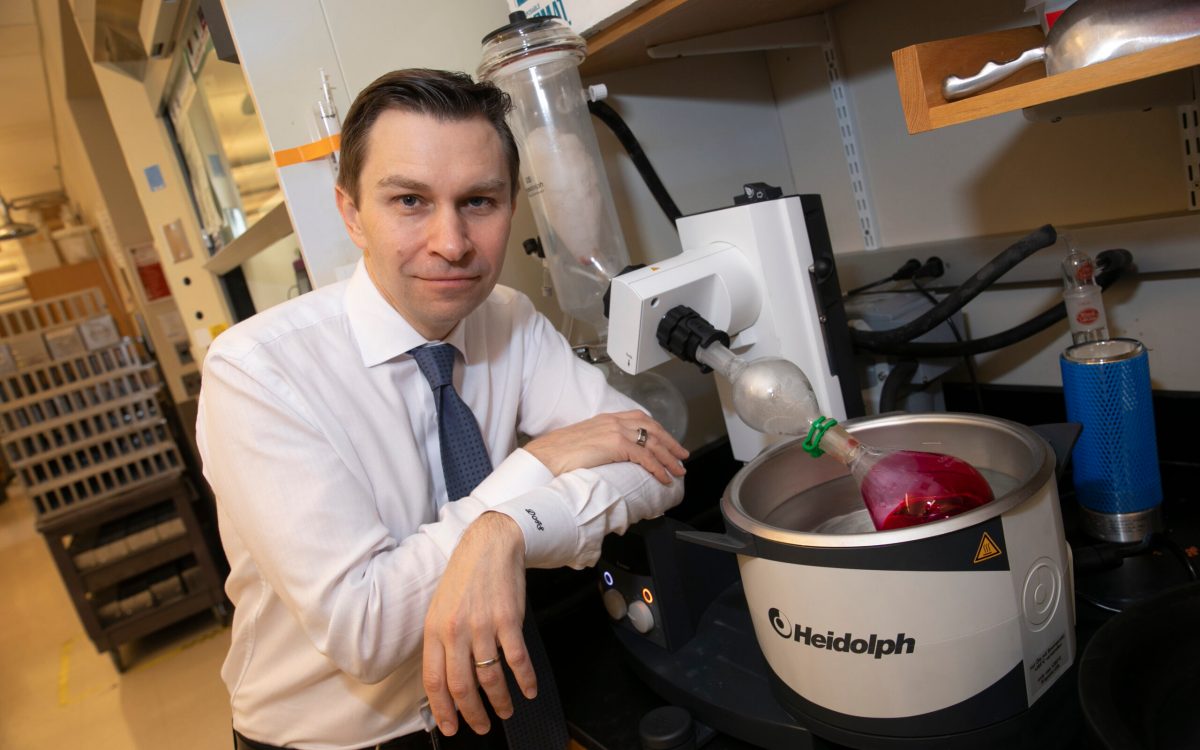
Sharon Inouye introduced the National Academy of Medicine prize contest that will award $30 million to foster innovations in healthy aging.
Rose Lincoln/Harvard Staff Photographer
A push to aid healthy aging
Medical School’s Inouye outlines Grand Challenge contest to fund innovations in field
The world’s aging population means there will be an increasing number of older and sicker people at a time when declining fertility will saddle a smaller working population with the burden of supporting them. One solution is to keep people healthier longer, living independently, and contributing to society. In pursuit of that goal, the National Academy of Medicine is mounting a $30 million Grand Challenge contest to foster innovation in science, medicine, public policy, the workplace, and elsewhere. Sharon Inouye, professor of medicine at Harvard Medical School and head of the Aging Brain Center at Harvard-affiliated Hebrew Senior Life, is a National Academy member and a member of the planning committee for the Grand Challenge for Healthy Longevity. She spoke to the Gazette about the contest and how she hopes it changes the nature of aging in the decades to come.
Q&A
Sharon Inouye
GAZETTE: Why is aging a priority now?
INOUYE: The population is shifting in the United States and around the world. Up until the early 1900s, America’s population pyramid had a very broad bottom — lots of young people — and a very narrow top, with older people a relatively small proportion of the population. Now, that pyramid looks more like a rectangle. By 2030, we’re going to have the same number of people under the age of 5 as over 65, with the most rapidly growing part over 80. That’s a huge inversion, and the reason is not only longer lifespans, but also fewer births. That is happening around the globe — at different speeds in different countries. It means there will not be enough young people in the workforce to support adults who are age 65, 70, and older, no longer contributing to the economy.
GAZETTE: And we’re not just older, but sicker?
INOUYE: That’s correct. People used to die younger from acute conditions like heart attack, stroke, cancers, infections, accidents, so forth. We’ve gotten better and better at treating those acute conditions so people are developing chronic conditions, like Alzheimer’s disease and other degenerative conditions. They’re living a long time with heart failure, lung failure, kidney failure. People now live a long time chronically ill; they get more and more disabled, and need a lot of health care services.
“Medicine is very focused on swooping in once diseases are diagnosed — and we do amazing things to keep people alive — but I think it sacrifices preventing conditions.”
GAZETTE: What is the Grand Challenge for Healthy Longevity?
INOUYE: In 2016, after Victor Dzau became president of the National Academy of Medicine, he surveyed the membership to determine priorities that the Academy should address. The two things that came out at the top were aging and health care disparities. Victor asked me to help organize the planning committee [on aging] and then things just started to happen in a whirlwind. He conceived of the Grand Challenge for Healthy Longevity, which has two big components: the Roadmap, which is the policy part, and the Grand Challenge Prize.
GAZETTE: What is the Roadmap and why is it important?
INOUYE: The Roadmap’s vision is not to provide answers, but to identify priority areas, questions that countries need to address to find solutions that change the face of aging in their localities. Three work groups will generate individual reports on science and technology, on health care systems and public health, and on social, behavioral, and environmental enablers. An international commission will develop a unified report that identifies the priority areas.
GAZETTE: And the goal is to make recommendations based on the best current science?
INOUYE: It is grounded in the evidence that we have, best-practice models, and the best science, but it’s really designed to be forward-looking. We need to think outside the box and identify areas where countries should focus in order to change the face of aging. What health care systems can we set up? How can we integrate community systems to better provide care across the lifespan? How can we intervene earlier — even from infancy or childhood — to make aging better? We can rethink our financing systems. We can rethink incentives in health care to provide good care, rather than care based on quantity. We can rethink the retirement age, because older adults are aging more successfully, and mandatory retirement is still in place in many countries. Older people can continue to contribute — and want to contribute — in many ways.
GAZETTE: How do we age today? Is it a good experience?
INOUYE: It is a highly variable experience and a lot of aging in our current health care system is really not good. In the United States, we need to put more attention and resources into community support for aging. Simple things like transportation for people who can’t drive anymore would make a huge difference in terms of quality of life and in terms of actually decreasing health care costs. Small investments in health promotion and preventive services, making sure every older adult has access to vaccinations, good nutrition, basic health care services, and essential medications could make a huge difference in people’s ability to remain at home and healthy as long as possible. We don’t have many alternatives for people who need chronic care. Most people don’t have the resources to afford staying at home because very little is covered by Medicare and other insurance. Their only option is to go to an assisted living facility or nursing home, which is not ideal because they are extremely variable in quality, and people don’t want to live out their lives in a facility.
“We’ve gotten better and better at treating those acute conditions so people are developing chronic conditions, like Alzheimer’s disease and other degenerative conditions. … People now live a long time chronically ill; they get more and more disabled, and need a lot of health care services.”
GAZETTE: Why don’t we shift to the second part of the challenge, the prize contest?
INOUYE: The Grand Challenge Prize is looking for bold, audacious innovations, ideas that can really change aging. We’re looking in science, in technology and engineering, in policy, social sciences, behavioral sciences, economic policy, in traditional medical science and health care, and in work focused on specific diseases. It’s really very broad. We’re looking for innovative thinking that can have global impact. The prizes are going to roll out on three levels. There will be 450 Catalyst Prizes awarded over a three-year period. The first of the three yearly calls will be in January 2020. Once it’s announced, there will be six weeks to submit your idea — just the idea, it doesn’t require any pilot work — and a two-page application. They’ll be reviewed within four months and prizes announced by July. The Catalyst Award is intended as seed funding to get the idea into its earliest stages of development. They’re relatively small in dollar amount, about $50,000 each, but they will give access to an annual meeting bringing together world experts in these fields.
GAZETTE: There’s a second-level prize as well?
INOUYE: In three years there will be the Accelerator Awards. The exact prize level is going to be somewhere in the range of $200,000 to $500,000. And those will be prizes for ideas that have achieved proof of concept already and hold great promise for commercialization. Those prizes will come with a path to commercialization. Anyone who gets an Accelerator Award will be invited, for instance, to present to Johnson & Johnson’s innovations group and similar groups like that around the world. A year or two after that, they’ll announce the Grand Prize. That’s going to be in the range of $2 million to $5 million. There will be one or two in the U.S. and there will be others around the world. Those will be for ideas that are considered breakthroughs and that have demonstrated substantial impact already.
GAZETTE: Your own work is in this area, isn’t it?
INOUYE: I work on a condition called delirium, or an acute confusional state, and its relationship to dementia. What I really look at is how the brain responds in the face of stress. My group looks at the response of older adults to scheduled surgery. That’s a huge stressor, and we try to follow how the brain functions before, during, and after surgery. Then we follow people long-term after surgery to see how they do. We look at who developed delirium, and it helps us understand how the brain fails in response to stress. Then we want to understand how we can bolster its functioning under stress. So we are also trying to look at who doesn’t develop delirium and how they are resistant to its effects. We learn as much from those who don’t develop it as we do from those who do. And then we look at the interrelationships of things like Alzheimer’s biomarkers to delirium, and inflammation and delirium. And we’re trying to see what we can do to intervene in this condition.
GAZETTE: Broadly speaking, what’s the potential for success in helping many more experience healthy aging than do today?
INOUYE: I think there’s enormous, enormous potential. We are gaining a lot of understanding about potentially modifiable targets for intervention. I feel that we are on the threshold, and I feel pretty confident that we’re going to make enormous advances in these next 10 years that will make aging and age-related conditions much better for everyone. I don’t know whether we’re going to be able to achieve healthy longevity for all in the next decade, but I definitely think we are heading in the right direction.
GAZETTE: If we are successful, what does old age look like 30 years from now from a work and retirement standpoint?
INOUYE: I would love to see people able to work as long as they want in capacities where they can be productive and contribute. That would mean workplaces offering flexibility so people can work part-time and have flexible hours. Many professions know that older adults can contribute in terms of experience and wisdom. They may be willing to do paid work and then transition to volunteer status in order to maintain health insurance benefits. If that was an accepted route, I think some people might choose it.
GAZETTE: What about from a health standpoint?
INOUYE: In health care, I would love to see us focus much more on prevention across the lifespan. Medicine is very focused on swooping in once diseases are diagnosed — and we do amazing things to keep people alive — but I think it sacrifices preventing conditions. I’m hoping that we can keep people living independently in the community as long as possible. At the tail end of life, we’re going to have people with severe illnesses, multi-morbidity, and some will require nursing-home-type care. Many people would rather not have that type of care but feel that there isn’t another environment in which they can get excellent health care and support at the end of life. I think sometimes we prolong life beyond what people want. If we really talked to them, we’d know how they wanted their last years to be. So the issue of palliative care and how we die is important. The Grand Challenge holds tremendous promise to catalyze tangible innovation [in these areas] to help all of us live healthier and more fulfilling lives to the end of our days.








